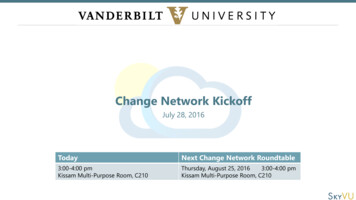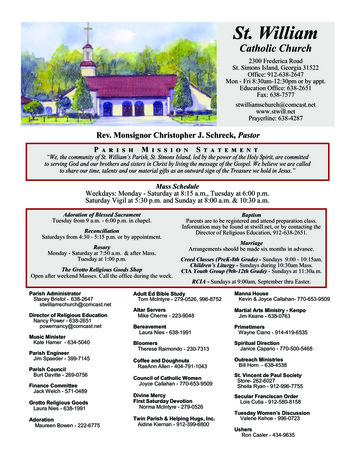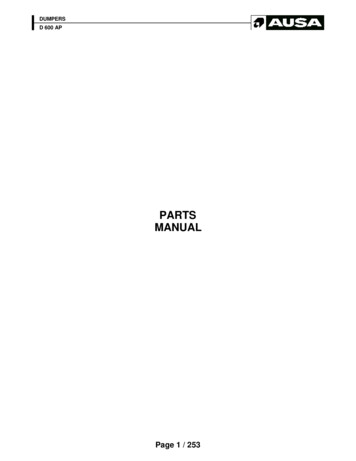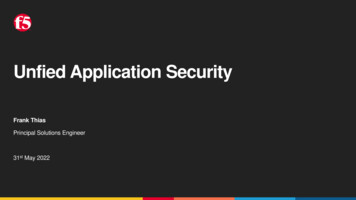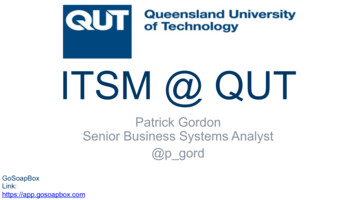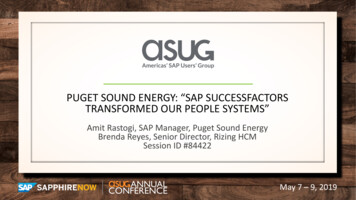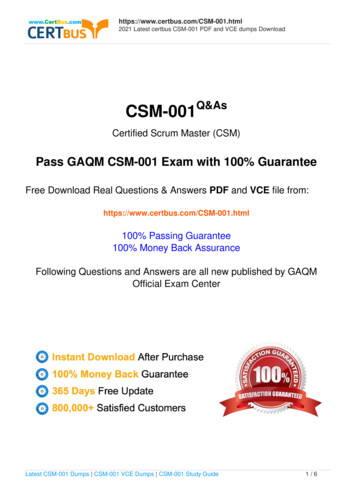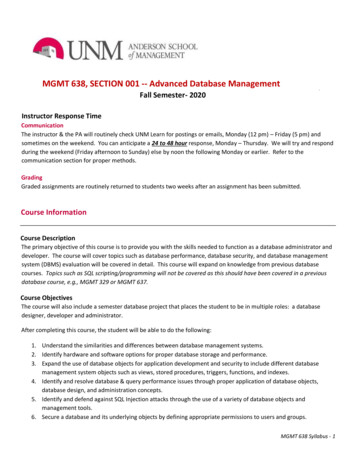
Transcription
MGMT 638, SECTION 001 -- Advanced Database ManagementFall Semester- 2020Instructor Response TimeCommunicationThe instructor & the PA will routinely check UNM Learn for postings or emails, Monday (12 pm) – Friday (5 pm) andsometimes on the weekend. You can anticipate a 24 to 48 hour response, Monday – Thursday. We will try and respondduring the weekend (Friday afternoon to Sunday) else by noon the following Monday or earlier. Refer to thecommunication section for proper methods.GradingGraded assignments are routinely returned to students two weeks after an assignment has been submitted.Course InformationCourse DescriptionThe primary objective of this course is to provide you with the skills needed to function as a database administrator anddeveloper. The course will cover topics such as database performance, database security, and database managementsystem (DBMS) evaluation will be covered in detail. This course will expand on knowledge from previous databasecourses. Topics such as SQL scripting/programming will not be covered as this should have been covered in a previousdatabase course, e.g., MGMT 329 or MGMT 637.Course ObjectivesThe course will also include a semester database project that places the student to be in multiple roles: a databasedesigner, developer and administrator.After completing this course, the student will be able to do the following:1. Understand the similarities and differences between database management systems.2. Identify hardware and software options for proper database storage and performance.3. Expand the use of database objects for application development and security to include different databasemanagement system objects such as views, stored procedures, triggers, functions, and indexes.4. Identify and resolve database & query performance issues through proper application of database objects,database design, and administration concepts.5. Identify and defend against SQL Injection attacks through the use of a variety of database objects andmanagement tools.6. Secure a database and its underlying objects by defining appropriate permissions to users and groups.MGMT 638 Syllabus ‐ 1
7. Understand the approaches of an audit in a database environment: from users to database objects.PrerequisitesMGMT 637 (Graduate‐Level Database Management) or MGMT 329 (Undergraduate‐Level Database Management)Course OrientationAn online orientation video will be posted on the course site (in UNM Learn). An additional online session using theembedded Collaborate system will be held on Sunday, August 26, 2018 at 9:15pm to answer any outstanding questionsor concerns. Please review the Online Session/Web Conferencing section for details on how to use the UNM LearnCollaborate system.Textbooks and Supplementary MaterialsRequired TextbookThere will be two sets of textbooks for this course; there are also optional texts that you may purchase. If you took thegraduate‐level database course (MGMT 637) within the last few years, you will be allowed to use the same text book byDavid Kroenke – Database Processing.Set #1 Required:O David M. Kroenke, D. Auer, Database Processing, 14th Edition, Prentice Hall, 2013, ISBN‐13: 978‐0133876703O Older editions of the Kroenke text (e.g. 13th Edition) will be accepted as the text will be used as a reference, and thecontent should be about the same as the current edition. Optional:O Michael J. Hernandez, Database Design for Mere Mortals, 3rd Edition, Addison‐Wesley, 2013, ISBN‐13: 978‐0321884497O Michael J. Hernandez, SQL Queries for Mere Mortals, 3rd Edition, Addison‐Wesley, 2014, ISBN‐13: 978‐0321992475O Joel Murach, Murach's SQL Server 2016 for Developers, Mike Murach & Associates, 2016, ISBN‐13: 978‐1890774967O Joel Murach, Murach's MySQL, 2nd Edition, Mike Murach & Associates, 2015, ISBN‐13: 978‐1890774820Set #2 ‐ Not needed until the middle of the semester (October 2018) Required: Alfred Basta, M. Zgola, Database Security, Delmar Cengage Learning, 2011, ISBN‐10: 1435453905,ISBN13: 978‐1435453906 Optional: Denny Cherry, Securing SQL Server, 3rd Edition, Syngress, 2015, ISBN‐13: 978‐0128012758You can acquire and/or rent these texts through a number of online sources (e.g. Amazon).Supplementary Materials1. Material from the text will be summarized in PowerPoint slides but the slides will not provide sufficient depth toprepare you for exams and assignments. Additional reference material will be posted on the course web sitethroughout the semester.MGMT 638 Syllabus ‐ 2
2. Additional videos will be posted to supplement lecture videos. Although it is not required to view these videos,they are beneficial to learning the material covered for the week that they are associated.3. Earphones. During online sessions, having earphones plugged into your system will allow you to hear thecontent better, but also reduce any feedback that may arise from your system’s microphone and speakers.4. If you are to meet with me for a personal online session, it is recommended that you have a system with amicrophone. If necessary, a separate headset with a microphone can be used in the Web Conference Link. It isnot required that you have a web cam.Course Software & Anderson Virtual Lab (VLAB)In order to access your online course, students will need to log onto UNM’s Learn online course system. In addition, thiscourse requires students to be able to open, use and read Microsoft Excel, Adobe Acrobat (PDF), and Word files. TheMicrosoft Office suite is preferred but not required. Office 2016 will be used by the instructor; Office 365/Office 2016 isavailable (for free) to all UNM students via the LoboMail portal.MS‐ISA and MBA‐MIS students also have the option to download Microsoft software from the Dreamspark portal, whichis accessible from the course site. Information about how to use Dreamspark will be described in the online orientationsession.Anderson VLABThe majority of homework projects will be completed using Windows Server 2012R2 (server) and SQL Server. Otherdatabase management systems (DBMS) may be introduced (e.g. MySQL or Oracle). The Anderson Virtual Lab (VLAB) willbe used in class to emulate a database server. A base server has been configured and made available to you. You mayuse a local installation of the DBMS system, but keep in mind, that depending on the assignment, you may need to usethe VLAB to post your solution. You can download a copy of SQL Server using Microsoft Dreamspark (see UNM Learnsite and orientation videos). The VLAB should be functional on almost all browsers. Note that the VLAB has beenupgraded for the Fall 2018 semester and is different from previous semesters. You will need to uninistall any add‐insthat you may have previously used from other classes that used the VLAB. Refer to the VLAB web site for informationon how to install and configure add‐ins for your system.To access UNM Learn and the VLAB, each student will use his/her NetID and associated password. To ensure that everystudent has access, it is advised that you change your password at the beginning of the semester. This will ensure thatyour NetID is recognized by the UNM LDAP/Active Directory infrastructure. Also, you will be eventually prompted tochange your password during the semester (required by UNM Policy). To change your password visit the following site:https://netid.unm.eduAnderson VLAB Web Site: http://www.mgt.unm.edu/technology/vlab (select MGMT 638)Accessibility & the VLABThe Anderson VLAB is a virtual environment featuring a different set of operating systems. The virtual system used forthis course is a Windows Server 2012R2 system. Although it is a virtual system, it is still a Windows system and employsthe same accessible features available in any Windows‐based system: high‐contrast, zoom capabilities, etc. Ifnecessary, a virtual system can be configured as an accessible system. Please contact the instructor so that the systemcan be configured accordingly.Windows 10 Accessibility Features: /default.aspxAdditional VLAB Accessibility InformationMGMT 638 Syllabus ‐ 3
VMWare ��vrealize‐automation6.2‐vpat.pdfTechnical ConsiderationsIn order to access your online courses students must log onto UNM Learn: https://learn.unm.edu. It is advised that youreview the Learn overview documentation.Online Course Requirements A high speed Internet connection is highly recommended. Supported browsers include: Internet Explorer, Firefox, and Safari. Access the following address for a detailedlist of supported browsers and operating Getting Started/Browser SupportAny computer capable of running a recently updated web browser should be sufficient to access your online course.However, bear in mind that processor speed, amount of RAM and Internet connection speed can greatly affectperformance.Online courses perform best on a high speed Internet connection. Those using slow internet connections willexperience longer page load times and much slower performance when accessing their online course. Many locationsoffer free high speed Internet access including UNM’s Computer Pods or one of UNM’s many Statewide Centers. For additional information: http://learn.unm.eduFor UNM Blackboard Learn & Web Conferencing Technical Support: (505) 277‐0857 or learn@unm.eduTechnical SkillsIn each assignment, you will be required to do a number of tasks with a computer. In order to participate and succeedin this class, you will need to be able to perform the following basic technical tasks: Use UNM Learn (help documentation located in "How to Use Learn" link on left course menu, and also athttp://online.unm.edu/help/learn/students/) Use email – including attaching files, opening files, downloading attachmentsCopy and paste within applications including Microsoft OfficeOpen a hyperlink (click on a hyperlink to get to a website or online resource)Use of different Microsoft Office applications o Create, download, update, save and upload MS Worddocuments o Create, download, update, save and upload MS PowerPoint presentations o Create, download,update, save and upload MS Excel spreadsheets o Download, save and upload PDF fileso Create, update, and save MS Visio diagrams (tutorials available when needed) Use the in‐course web conferencing tool (Collaborate Web Conferencing software)Download and install an application or plug in – required for participating in web conferencing sessions and useof the Anderson VLAB.Additional Technical RequirementsMGMT 638 Syllabus ‐ 4
For using the Kaltura Media Tools inside Learn, be sure you have downloaded and installed the latest version ofJava and Mozilla Firefox.Microsoft Office products are available free for all UNM students (more information on the UNM IT SoftwareDistribution and Downloads page: http://it.unm.edu/software/index.html)For UNM Learn Technical Support: (505) 277‐0857 (24/7) or use the Create a Support Ticket link in your course.Assessment and GradingInstructor ExpectationsI will give each of you 100% of my commitment to help you successfully complete this class, however, I expect 100% ofyour commitment to this class, which includes reading the textbook, using the resources available in UNM Learn,watching posted videos, posting questions in the discussion board, completing your homework, working within groups,preparing for exams, reviewing your graded homework and exams, and following up with questions to the instructor.ExamsTwo (2) exams will be given and are listed in the course schedule. Review questions will be distributed before eachexam. The online meeting prior to each exam date will be devoted as an exam review. In addition, a week will bededicated to exam review so you may prepare for the exam.Exams will be done in‐person. In‐person exams are scheduled to be taken in the Anderson Computer Lab, MCM 2060.See the schedule for exact exam dates and times. If you cannot attend an exam date or need services not offered atAnderson, please notify the instructor at least 2 weeks prior to the scheduled exam.If a student lives more than 90 miles outside of the Albuquerque area, students can arrange (with instructor approval) totake an exam at a UNM branch campus or a pre‐approved testing site. Students must request approval to take an examat another testing site four (4) weeks before the exam date. Students must arrange a date and time for the exam, andconfirm the test date with the instructor and the proctored site. Contact the instructor for a list of “UNM approved”proctor sites.As with all exams, it is your responsibility to be prepared and honest. Any signs of dishonesty will be severely punished.If there is clear evidence of cheating, the students involved will receive a failing grade (zero points) for the exam.Recovering from a failing grade will be detrimental towards receiving a passing grade for the course.AssignmentsThere will be two sets of assignments for the course, Lab Exercises and a Group Project.Lab Exercises:Lab exercises will be issued during the semester. Each lab is a practical exercise that requires you to complete tasksnormally performed by a database administrator. Instructions for each lab will be distributed at least two weeks prior tothe due date. Students will be expected to complete each lab, individually.Cheating will be addressed. Examples of cheating include having another person do your assignment or submittinganother student’s submission. If there is clear evidence of cheating, the students involved will receive a failing grade(zero points) for the assignment. Just like a failed exam, recovering from a failing grade will be detrimental towardsreceiving a passing grade for the course.MGMT 638 Syllabus ‐ 5
Group Project:To fully grasp the material, students will be required to perform a project that involves a local business or organizationand evaluates the organization’s current database system. You will be assisting the organization in creating orredesigning a new system.It is strongly recommended that groups be kept small – no more than 4 people. If necessary, the group may be dividedinto smaller groups. More details about the group project will be distributed on the course site.A number of milestones will be required of each group. The milestones will be graded and applied to the overall projectgrade. Details about the project as well as milestone dates will be provided in a separate document on the course site.It is recommended that all milestones be met in order to achieve the best possible grade for the project.Due Dates & Late Submissions:Assignments due dates are listed in the Course Schedule on the course site in UNM Learn. Keep in mind that due datesmay change. An announcement will be posted in UNM Learn regarding any changes to the dates. The Course Schedulewill be updated accordingly. Late assignments will be penalized and only accepted 2 days after the due date of theassignment. Submissions after the second day will not be considered and will be recorded as a “zero” for thatassignment.A “late points” column will be posted in the course’s Grading Center in UNM Learn. The column will contain the numberof points that will be deducted from your assignment total points if you submitted any of those assignments after thedue date. The column will be cumulative and will be updated after each assignment. Ten (10) points will be added tothe column per day late with a maximum of 20 points per assignment. If your column has a “zero” (0) value, then nopoints will be deducted from your total lab exercise points. Keep in mind that late points will affect your final gradeespecially if you submitted more than one assignment late.Grade WeightingAlthough graded assignments and exams will be posted in UNM Learn, the system is NOT the official grade book for thiscourse. I use an external file to store assignment and exam points, which will then be used to calculate your final grade.Please refer to the grade distribution below.1. Exams: 30% (Exam 1 ‐ 15%, Exam 2 ‐ 15%)2. Lab Exercises (6): 30% (equally weighted)3. Group Project: 40%Final grades will be issued on a fractional basis. I believe that an “A” is different than an “A‐“, a “B ” is different than a“B”, etc. If you put forth the effort, you can earn the grade that you set to achieve. I follow the standard grade pointsfor letter grades:Grade Letters and PercentagesA : 100‐97%A: 96‐93A‐: 92‐90B : 89‐87B: 86‐83B‐: 82‐80C : 79‐77C: 76‐73C‐: 72‐70D : 69‐67D: 66‐63D‐: 62‐60MGMT 638 Syllabus ‐ 6
F: 59 Or Less“A ” grades can only be earned if the student goes above and beyond what is required. To earn an “A ”, the studentmust do the following:1.2.3.4.Complete ALL assignments.Assignments must be submitted on time ‐ no late submissions.The extra credit sections on the assignments must be attempted when made available to the class.The student must have earned the proper number of total percentage points for an A (97 points or higher).Participation & TrackingClass Participation & PostingsJust because the class is a distance learning class does not mean we are disconnected. The posting of homeworkassignment questions creates a learning community where students are supported and frustrations are reduced whilealso reinforcing knowledge.If you choose to participate, keep in mind that postings in Discussion boards should be constructive and supportive.Postings should guide students to how to solve a problem, but not provide actual answers. This class is about learningand/or refining your knowledge about databases. By using somebody else’s answers, you are cheating yourself, andyour lack of knowledge will be reflected in your exams.UNM Learn TrackingUNM Learn automatically records all students’ activities including: your first and last access to the course, the pages youhave accessed, the number of discussion messages you have read and sent, chat room discussion text, and posteddiscussion topics. This data can be accessed by the instructor to evaluate class participation and to identify studentshaving difficulty.Web Conferencing: CollaborateWeb conferencing is available in UNM Learn and will be used in this course for meeting with the instructor. As thelectures may not be enough for you to learn the material, optional online meetings will be made available for studentsto ask questions. Every two weeks (day & time TBD), an online Q&A session will be held using Collaborate in UNMLearn. The session will be offered to all students to ask any outstanding questions. The session will also be recorded soyou can review the material again, or if you happened to miss a session, you can view the material covered in eachsession. These sessions are optional, but provide a good basis to interact with the instructor and gain additionalinformation related to assignments, the project, and exams. When necessary and requested, additional sessions may beadded and will be posted in advance on the UNM Learn site.Each online session will be recorded and available the day after the session. I will be noting which students have activelyparticipated in each session. Showing up and leaving within the first 15‐20 minutes will not constitute participation.There will be announcements and topics discussed throughout the entire session. It is in your best interest to “attend”MGMT 638 Syllabus ‐ 7
and watch a number of these sessions. In past semesters, these sessions have been valuable in clarifying the materialand allowing students to succeed.Students are expected to be prepared for online meetings. Learning is enhanced when all are prepared. The instructormay ask questions from each student during the session. Personal experiences that apply to the discussed material areencouraged. In addition, the sessions tend to be visual and those who learn visually will benefit.The Collaborate system (available from the course main page) will allow the instructor to interact with each student. Itis advised that you have the latest Java updates applied to your system. Based on experience, Firefox may work betterwith UNM Learn than Internet Explorer. If you are having difficulties accessing the site and/or Collaborate, considerusing another browser.For the online sessions, you will need: Earphones. Quality entry models are widely available at BestBuy, Walmart or online.Internet Connection. A high speed internet connection is highly recommended for these sessions. A wirelessinternet connection may be used if successfully tested for audio quality prior to web conferencing.Java installed & updated. The latest version of Java should be installed and updated on the system you are usingto connect. Visit www.java.com to acquire the latest version.A test Collaborate session will be available to allow you to connect and test your connection and sound. Access the WebConferencing link (left‐side navigation).Course ExpectationsCourse ExpectationsAlthough the basic organization of the course should remain constant, other factors may change during the semesterincluding the scope, number and timing of assignments, format of lectures, online meeting times, and the format andcontent of exams. Because of the potential for change, you should not assume that anything in the schedule is set instone. You should also ensure that you keep up with the class through viewing the lecture material, regular“participation” within discussions, and prompt assignment completion. Students who "disappear" for an extendedperiod may find the course substantially altered when they return.As with all courses, you are expected to devote an adequate amount of time for this course. Expect to spend at least 15hours per week, which includes reading the text, reviewing lectures, working on assignments. DO NOT TRY TO DOEVERYTHING IN ONE DAY! Do a little every day. There is not enough time in one day to do it all.Weekly TasksThis course may be time intensive. You will be required to do many more things than other Anderson ANDMSISA/MBA‐MIS courses. Use the following as a guide to completing the requirements of each week.1. All the information you need for each week is found under the corresponding weekly module. 2.Each module includes:a. PowerPoint or other instructor handoutsb. Lecture videosMGMT 638 Syllabus ‐ 8
3.4.5.6.7.8.9.10.c. Access to the current homework assignmentd. Weekly Discussion Board – Use this to review any questions that may have been posted along withpotential answers to those questions.e. Additional information pertaining to the topic of the week.Read the assigned chapter(s) for the week (see the Course Schedule)Review the PowerPoint slides.View the lecture videos, which discuss the material. The videos will be recorded so that as much informationcan be delivered, and as a result, the length of the video content may be large. The videos will be broken intosmaller, digestible pieces that should not be longer than 20 minutes. The videos will also illustrate how toapproach and solve the homework assignments. Take a set of videos in chunks at a time (one or two a day).Although optional, a bi‐weekly online Q&A session will be available. The day and time will be determined inweek one based on student availability. It is strongly recommended that you “attend” the online sessions.Post any questions about the homework or project in Discussions under the appropriate topic/week.Complete the assigned homework assignment per the Course Schedule. Students are expected to complete theassigned homework on their own. Questions about assignments should be posted under the appropriate topicin Discussions (on UNM Learn).If you need to post a message only to the instructor use UNM Learn’s course messages and select “Josh Saiz”.Email messages directly to the instructor (using your UNM email address) should not be sent unless it’s anemergency. Refer to the Communication section regarding email.Each week will start on a Tuesday and end the following Monday. Keep in mind that I may not always have eachweekly module 100% complete at the beginning of each week. I will attempt to have a general outline of eachweek’s expectations posted at the beginning of the week, but by the end of the week, the week’s material willbe completely accessible.An example week: Tuesday: Log on to UNM Learn and review any messages/announcements. Read the material for the week. Wednesday: Log on to UNM Learn and review lectures: slides & videos (if available). Thursday: Log on to UNM Learn and finish lectures; review the assignment; work on assignment/project Friday: Log on to UNM Learn and review messages/announcements; start/continue assignment and/or project. Saturday/Sunday: Continue the assignment and review any messages/announcements on Learn. Attend/reviewonline session (if available). Monday: Continue or finish up assignments and review any messages/announcements on UNM Learn.Attend/review online session (if available).Course CommunicationThe majority of communication will take place on the Learn course site. As there is an email component within Learnthat pertains to this course, all email communication between the student and instructor will take place using the UNMLearn Messages/email interface. Much of my email is work related and managing work and course email can beconfusing. Your message can be lost in my Inbox as I tend to receive more than 100 messages a day. To minimize anyloss of email communication, all email should be sent using UNM Learn and NOT sent to the instructor’s email addressunless it’s an absolute emergency. Responses to your email questions will be done within 24‐48 hours (1‐2 days). Ifyou submit a question during the weekend, a response may not be submitted until the following Monday or SundayMGMT 638 Syllabus ‐ 9
evening. I will attempt to respond to “weekend” submissions as soon as I am able. Check your Learn messages andannouncements regularly as you may miss something related to course assignments and material.Netiquette Ground Rules In following with the UNM Student Handbook, all students will show respect to their fellow students andinstructor when interacting in this course. Take Netiquette suggestions seriously. Flaming (personal insults orattacks) is considered a serious violation and will be dealt with promptly. Postings that do not reflect respectwill be taken down immediately.Respect others’ Copyrights – quote and cite. Don’t type in ALL CAPS. Use proper grammar and spelling (type your postings in Microsoft Word first in order to use spell check thencopy and paste into UNM Learn). Students are expected to follow UNM’s Respectful Campus Policy 2240.Instructor Drop PolicyThe instructor may drop a student, if the student does not complete the Questionnaire Survey, Welcome Survey orWelcome Posting by the end of the first Sunday of the course. The instructor may also drop a student during thesemester, if a student misses assignments or an exam and does not contact the instructor within one week of thefailed/ missed assignment or exam. Students who miss Exam 1 and do not contact the instructor via UNM Learnmessaging within one week of the close of Exam 1 will be dropped from the course. Students who have not droppedand do not take the final will receive a “W” (Withdraw) for the course.This course falls under all UNM policies for the last day to drop courses, etc. Please seehttp://www.unm.edu/studentinfo.html or the UNM Course Catalog for information on UNM services and policies.Please see the UNM academic calendar for course dates, the last day to drop courses without penalty, and for financialdisenrollment dates.Academic IntegrityEach student is expected to maintain the highest standards of honesty and integrity in academic and professionalmatters. Dishonesty is defined as a lack of truth, honesty or trustworthiness. Cheating is defined as influencing orleading by deceit. Deceit is defined as intending to mislead and commonly suggests a false appearance.Students should be familiar with UNM’s Policy on Academic Dishonesty and the Student Code of Conduct which outlineacademic misconduct defined as plagiarism, cheating, fabrication, or facilitating any such act.Examples (not exhaustive) of dishonest behavior include: Uses or attempts to use unauthorized aids in examinations or other academic assignments to be submitted forevaluation Misrepresentation of data, results or sources for papers or reports Coping and submitting another student’s workMGMT 638 Syllabus ‐ 10
Anderson School of Management faculty, staff and students commit to values of trust, honesty,integrity, and accountability. We will not tolerate academic dishonesty. By enrolling in anycourse at Anderson, the student accepts the Anderson Academic Honesty Code and affirmsthe following pledge: I will not lie, cheat, fabricate, plagiarize or use any other dishonestmeans to gain unfair academic advantage.Any violation of the code of conduct will be taken very seriously and appropriate sanctions will be applied. For full textof Anderson’s Academic Honesty Code, please visit http://www.mgt.unm.edu/honestyIf cheating is detected (exam or assignment submission), students will be required to meet with the instructor, and ifnecessary Anderson’s Deans. If justifiable cause is determined, the affected student(s) will be dropped from the courseand an “F” will be issued.Student e‐ReadinessOnline classes are often incorrectly thought to be easier than in person classes. Online courses are not correspondencecourses. They are designed to mirror in person classes and due to the self‐ discipline required they can be morechallenging than in person classes. If this is your first online class please take UNM's Online Class Readiness Quiz. A linkto the quiz will be made available on the course site.Students with DisabilitiesQualified students with disabilities will be provided reasonable and necessary academic accomm
1. Understand the similarities and differences between database management systems. 2. Identify hardware and software options for proper database storage and performance. 3. Expand the use of database objects for application development and security to include different database



